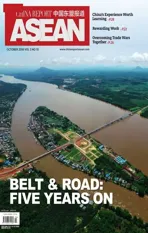MULTIPLYING EFFECTS
2018-11-05ByHouWeili
By Hou Weili
Village leaders from China and Southeast Asia exchange practices to add value to agricultural production and build beautiful countryside
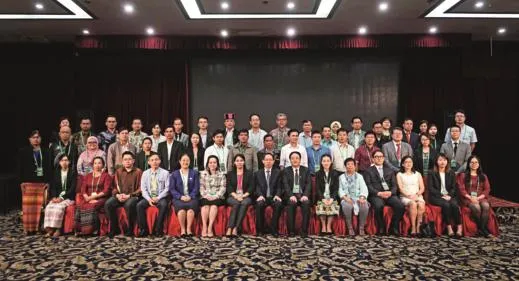
A group photo of participants of the 7th ASEAN+3 Village Leaders Exchange Program held in Beijing from September 10 to 14.
Before leaving to return home, Khankeo Keomayphith, an official from Laos overseeing rural affairs,stopped by the snack store of Yushiyuan at Beijing Capital International Airport. She was already acquainted with local specialties on shelves thanks to an exchange program hosted by the International Poverty Reduction Center in China (IPRCC) and attended by rural officials from Chinese provinces of Gansu and Yunnan as well as those from Southeast Asian countries. Along with the local Beijing bites, she will bring back stories behind the snacks which were served to the royal Chinese family.
The snacks are still processed from chestnuts,peaches and water-chestnuts grown in Beijing’s northern suburban Huairou District and rural areas across China including in Hunan Province. Rural residents have pooled their capital, labor and farmland to establish agricultural cooperatives and increase productivity and added value. The cooperatives,with integrated resources and consolidated strength,explore partnerships with businesses like food producer Yushiyuan and launch training programs to improve farmers’skills regularly. Farming is based on orders received from companies.
“This model can really help increase farmers’ income,”remarked Khankeo, director of the Department of Rural Development and Cooperative with the Ministry of Agriculture and Forestry of Laos. “And the farmer doesn’t have to worry about finding a buyer for the product.” One of some 50 members of the 7th ASEAN+3 Village Leaders Exchange Program, she discovered a lot more inspiring practices like cooperatives to add value to agricultural produce and build beautiful countryside. During the seven days, village heads from Southeast Asian countries also shared their poverty alleviation experience with their Chinese counterparts from Gansu and Yunnan, where regional poverty remains a daunting challenge to be overcome to achieve China’s pledge to lift all people out of poverty by 2020.
The program started in 2011 at the ASEAN+3 High-Level Officials Meeting on Rural Development and Poverty Reduction held in Bangkok,Thailand based on a suggestion by the Malaysian delegation.Since then, village heads from ASEAN member states have traveled to China, Japan and South Korea to witness how their counterparts govern and develop rural areas.
China heeded the call and took the lead in making the initiative a reality. The first ASEAN+3 Village Leaders Exchange Program was launched by the IPRCC in 2013. To date, seven programs have been launched with the fifth one being hosted by Malaysia. “Exchange at the primary level in terms of poverty alleviation has become institutionalized and embraced by each participating country,” noted IPRCC Director General Zuo Changsheng when addressing the opening ceremony of the seventh event.“The mechanism is shared by ASEAN+3 nations and has been proven highly productive.”
Empowering the People
Participants of the event in Beijing found the partnership between agricultural cooperatives and established companies has extended far beyond the farming sector.Tianxianyu Village in Huairou District was once a poor place at the foot of the Great Wall. Villagers subsisted by growing chestnuts, plums and persimmons. In the past,adjacency to Beijing didn’t foster much prosperity for the small village and instead drained its talent pool, leaving dilapidated farmhouses and unattended seniors and children.
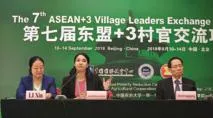
The 7th ASEAN+3 Village Leaders Exchange Program was held in Beijing from September 10 to 14.
“Young people head off to find work in downtown Beijing after graduation,” reported Chen Mingjie, a resident of Tianxianyu Village. “Only the elderly stay and work the deteriorating land.”
China called for a nationwide campaign to build beautiful countryside in 2013,aiming to inject rural areas with thriving businesses, pleasant living environments, social etiquette and civility, effective governance and prosperity, as outlined in a report delivered by General Secretary Xi Jinping to the 19th National Congress of the Communist Party of China in October 2017.
Under these guidelines,Tianxianyu Village explored avenues to build beautiful countryside based on its unique conditions. Beijing real estate developer Guoao Group determined that its location at the foot of the Great Wall and pleasant natural environment endowed by surrounding clear waters and lush mountains were potentially valuable tourism resources if the area developed into an escape for stressed-out urbanites from nearby Beijing.
In 2015, the village cooperative, on behalf of the villagers, reached a partnership agreement with Guoao Group to renovate the idle dilapidated farmhouses into upmarket lodges with full amenities to attract urban tourists. Under the partnership, Guoao Group paid for 30-year management rights to the houses owned by local farmers at a price around 300,000 yuan (US$43,719) for each. It manages operations and pays property owners dividends on a yearly basis.
So far, the company has opened 44 courtyards as destinations to experience idyllic life with a daily rate ranging from 2,000 (US$291.5)to 3,000 yuan (US$437.2).They have been popular in the market. “You have to make a reservation at least a week in advance to secure a weekend, and months earlier for peak seasons,” illustrated Chen, a local who works as a receptionist for Guoao Group.
“In addition to 300,000 yuan from rental income, I can receive tens of thousands of yuan in dividends from the booming tourism,” she continued. “The receptionist job earns me an extra 2,500 yuan (US$364.3) every month.”Another 18 local residents like her are employed by Guoao to assist with the project.During harvest season, they are granted time off to gather chestnuts.
“This project is empowering the people in real sense,”beamed Celia Flor, sectoral representative for women from the National Antipoverty Commission of the Philippines. “Once idle resources have been fully tapped to increase income.Farmers maintain their right to use the property while receiving benefits from it.”
Greater Exploration
Explorations on reducing poverty and revitalizing rural areas transcend these models.Ye Jingzhong, a sociologist from China Agricultural University,launched an experiment to cultivate “nested market,” a concept jointly proposed by Ye and his counterparts from Brazil and the Netherlands eight years ago, in Sanggang Village in northern China’s Hebei Province.
According to their plan,villages near Beijing in which the ecological environment and traditional agricultural practices have been wellpreserved are designated as food-producing bases. Leftbehind poverty-stricken households produce crops,vegetables and eggs with natural input rather than machinery and chemicals and sell them directly to urban consumers. No intermediate traders are needed.
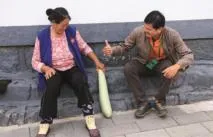
Below: A Thai representative talks with a local farmer in Huairou, a northern suburb of Beijing.
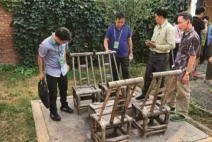
Bottom: Village heads from ASEAN countries visit a courtyard lodge renovated from dilapidated farmhouses.
“By doing it this way,rural residents first establish direct interaction with urban consumers and then provide them with safe reliable alternative food as standardized and industrialized agricultural products,” Ye explained.
According to him, in the current volatile global food market, producers are isolated from consumers by intermediate traders who exploit the largest share of profits and control the production chain from farm to table.
He likened the nested market to a bird’s nest which is created by intertwining food producers and consumers. “They are in a community with shared values and contribute to fostering a new type of rural-urban relations,” added Ye, noting farmers more easily earn greater wealth by performing better in this model.
The model has proved highly effective. In 2016, it brought poverty-stricken households in Sanggang Village stable monthly income of about 30,000 yuan (US$4,371). More jobs were created by a butchery,meat processing and packaging plants and delivery companies.
Changes include not only financial gains, but also rural residents’ attitude about nature. For environmental protection reasons, local residents are becoming conscious of reducing usage of chemical fertilizers,revealed Ye, noting that all human beings, whether in the countryside or cities, have many things in common.
“By fostering nested markets, we are rebuilding the rural-urban relationship and trust among people, which is something all of society,in the international scope,desperately needs,” Ye said.
Khankeo echoed his sentiments and called the explorations refreshing and inspirational, predicting how some could be adapted to local conditions. “If we know each other better, we can find more potential areas to work together,” she said.
For Thin Zar Nyunt, staff officer with the Department of Rural Development, Ministry of Agriculture, Livestock and Irrigation, Nay Pyi Taw Territory in Myanmar, the program provides a good chance to learn practices they didn’t know and apply some back home.“For example, in Myanmar, we have rural households working as partners at a small scale to breed pigs and perform farming, which can be regarded as a basic incarnation of these cooperatives,” she said.
CHINA AIMS FOR BEAUTIFUL COUNTRYSIDE WITH THRIVING BUSINESSES, PLEASANT LIVING ENVIRONMENTS, SOCIAL ETIQUETTE AND CIVILITY, EFFECTIVE GOVERNANCE AND PROSPERITY.
